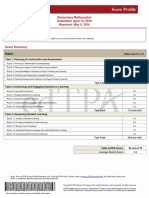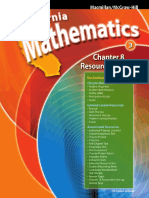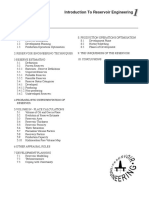Grade 4 Parent Brochure
Grade 4 Parent Brochure
Uploaded by
api-261342302Copyright:
Available Formats
Grade 4 Parent Brochure
Grade 4 Parent Brochure
Uploaded by
api-261342302Original Title
Copyright
Available Formats
Share this document
Did you find this document useful?
Is this content inappropriate?
Copyright:
Available Formats
Grade 4 Parent Brochure
Grade 4 Parent Brochure
Uploaded by
api-261342302Copyright:
Available Formats
Parent
Roadmap
Grade 4
Cobb County Schools
Multiplication & Division
Working with Fractions
2013-2014
Students in fourth grade are encouraged
to see the relationship between
multiplication and division. Their task is
to make sense of division and have a real
understanding of the concept thereby
preparing for more complicated
strategies in subsequent grades. One
strategy that supports this is multiplying
up.
This student has used the multiplying up
strategy to find the solution to 624 6.
Students need to see fractions on a
number line and apply this to different
situations.
A fourth grader should develop an
understanding of a fraction as a number.
Grade 4 expectations when working with
fractions are limited to fractions with
denominators 2, 3, 4, 5, 6, 8, 10, 12, and 100.
Students are
exposed to various
strategies to
ensure a good
foundation is
laid as students
move into the
middle grades.
One strategy, partial quotients, begun in
grade 3 continues in grade 4 with larger
numbers.
*
Understanding fraction equivalence is very
important in grade 4. Students need to
understand how an equivalent fraction is
obtained. =
* + :
The whole is the square, measured by area. On
the left it is divided horizontally into 3 rectangles
of equal area, and the shaded region is 2 of these
and so represents . On the right it is divided into
4 x 3 small rectangles of equal area, and the
shaded area comprises 4 x 2 of these and so it
represents 4 x 2
4 x 3
A fourth grader has to understand the unit
fraction and be able to apply this
understanding to addition and subtraction
of fractions.
= + + + +
OR + etc.
`*
* `*
* `* `* `* `*
Parent
Roadmap
Grade 4
Cobb County Schools
Multiplication & Division
Working with Fractions
2013-2014
Students in fourth grade are encouraged
to see the relationship between
multiplication and division. Their task is
to make sense of division and have a real
understanding of the concept thereby
preparing for more complicated
strategies in subsequent grades. One
strategy that supports this is multiplying
up.
This student has used the multiplying up
strategy to find the solution to 624 6.
Students need to see fractions on a
number line and apply this to different
situations.
A fourth grader should develop an
understanding of a fraction as a number.
Grade 4 expectations when working with
fractions are limited to fractions with
denominators 2, 3, 4, 5, 6, 8, 10, 12, and 100.
Students are
exposed to various
strategies to
ensure a good
foundation is
laid as students
move into the
middle grades.
One strategy, partial quotients, begun in
grade 3 continues in grade 4 with larger
numbers.
*
Understanding fraction equivalence is very
important in grade 4. Students need to
understand how an equivalent fraction is
obtained. =
* + :
The whole is the square, measured by area. On
the left it is divided horizontally into 3 rectangles
of equal area, and the shaded region is 2 of these
and so represents . On the right it is divided into
4 x 3 small rectangles of equal area, and the
shaded area comprises 4 x 2 of these and so it
represents 4 x 2
4 x 3
A fourth grader has to understand the unit
fraction and be able to apply this
understanding to addition and subtraction
of fractions.
= + + + +
OR + etc.
`*
* `*
* `* `* `* `*
For information on open
positions or to submit your
resume, please visit our Web
site at:
www.lucernepublishing.com
By the time students reach 4
th
grade,
they have mastered addition and
subtraction strategies. Students now
understand the standard algorithm for
addition and subtraction and are able to
apply it fluently to solve real-world
problems.
Fourth graders come to this grade level
knowing multiplication facts from
memory. Students can use strategies to
help them with these facts:
8 x 9 could be seen as
OR
Math
8 x 10 = 80
80 8 = 72
8 x 5 = 40
8 x 4 = 32
72
Once students have understood the models
and can apply the distributive property to
these multiplication problems they move to
partial products.
800 180
0
240 54
40 9
20
6
Students draw
models and
calculate the
product.
4 9
x 2 6
5 4
240
180
800
1274
Fourth graders explore division by finding
whole number quotients and remainders
using strategies based on place value and
the properties of operations. A strategy,
based on place value that is used to assist
students with understanding division is
explicit trades.
In this example, the student had to trade 2
tens for 20 ones. This should be clearly
explained using place value language.
A strategy that helps students multiply
numbers mentally is doubling and halving.
Here the student halves one number and
multiplies the other number by two to get a
friendly number that is easy to work with
mentally.
A fourth grade student is familiar with
building simple multiplication problems
using base ten blocks. This drawing
shows the problem 13 x 4.
Students investigated working with the
distributive property in grade 3.
4 x 13 = 52
(4 x 10) + (4 x 3)
Students now begin to work with the area
model of multiplication using 2-digit x 2-digit
numbers.
Here a student has built a 12 x 23 area model
that shows the product 276.
Once again, the distributive property (based
on the model) helps students understand
multiplication.
12 x 23 = 276
(10 x 20) + (2 x 20) + (10 x 3) + (2 x 3)
200 + 40 + 30 + 6
10 + 3
4 4 x 10 4 x 3
For information on open
positions or to submit your
resume, please visit our Web
site at:
www.lucernepublishing.com
By the time students reach 4
th
grade,
they have mastered addition and
subtraction strategies. Students now
understand the standard algorithm for
addition and subtraction and are able to
apply it fluently to solve real-world
problems.
Fourth graders come to this grade level
knowing multiplication facts from
memory. Students can use strategies to
help them with these facts:
8 x 9 could be seen as
OR
Math
8 x 10 = 80
80 8 = 72
8 x 5 = 40
8 x 4 = 32
72
Once students have understood the models
and can apply the distributive property to
these multiplication problems they move to
partial products.
800 180
0
240 54
40 9
20
6
Students draw
models and
calculate the
product.
4 9
x 2 6
5 4
240
180
800
1274
Fourth graders explore division by finding
whole number quotients and remainders
using strategies based on place value and
the properties of operations. A strategy,
based on place value that is used to assist
students with understanding division is
explicit trades.
In this example, the student had to trade 2
tens for 20 ones. This should be clearly
explained using place value language.
A strategy that helps students multiply
numbers mentally is doubling and halving.
Here the student halves one number and
multiplies the other number by two to get a
friendly number that is easy to work with
mentally.
A fourth grade student is familiar with
building simple multiplication problems
using base ten blocks. This drawing
shows the problem 13 x 4.
Students investigated working with the
distributive property in grade 3.
4 x 13 = 52
(4 x 10) + (4 x 3)
Students now begin to work with the area
model of multiplication using 2-digit x 2-digit
numbers.
Here a student has built a 12 x 23 area model
that shows the product 276.
Once again, the distributive property (based
on the model) helps students understand
multiplication.
12 x 23 = 276
(10 x 20) + (2 x 20) + (10 x 3) + (2 x 3)
200 + 40 + 30 + 6
10 + 3
4 4 x 10 4 x 3
You might also like
- Morning Jumpstarts 2 - 1Document113 pagesMorning Jumpstarts 2 - 1Rajitha RaviNo ratings yet
- Math Big Ideas NCSM Spr05v73p9 24Document16 pagesMath Big Ideas NCSM Spr05v73p9 24Naini SinghNo ratings yet
- Make Equal GroupsDocument2 pagesMake Equal Groupsapi-538027059No ratings yet
- Edtpa ScoreDocument7 pagesEdtpa Scoreapi-301370601No ratings yet
- Module 8 PDFDocument2 pagesModule 8 PDFapi-3769640700% (1)
- Math Chapter 5 Lesson 4 My HomeworkDocument2 pagesMath Chapter 5 Lesson 4 My Homeworkapi-302987446No ratings yet
- Parent Letter For Practicing Multiplication Facts at HomeDocument2 pagesParent Letter For Practicing Multiplication Facts at Homeapi-466283800No ratings yet
- Iready Award CardsDocument2 pagesIready Award CardsAlicia MillerNo ratings yet
- Math Interventions. What Are: Examples of Math Interventions P That Can Be Used in The Classroom? Classroom?Document35 pagesMath Interventions. What Are: Examples of Math Interventions P That Can Be Used in The Classroom? Classroom?Abril MayoNo ratings yet
- Free Adding Integers: Promoting Success For You & Your Students!Document11 pagesFree Adding Integers: Promoting Success For You & Your Students!Nora HafizanNo ratings yet
- Parent Handbook Grade 3 Module 1Document15 pagesParent Handbook Grade 3 Module 1api-261399250No ratings yet
- Dot Pattern/Ten Frame/Mathrack CardsDocument21 pagesDot Pattern/Ten Frame/Mathrack CardsMary Mc PhersonNo ratings yet
- Spiral Math 4 (Second Edition) TMDocument125 pagesSpiral Math 4 (Second Edition) TMBenazir MotasamNo ratings yet
- Add and Subtract Fractions With Unlike Denominators 7 +Document5 pagesAdd and Subtract Fractions With Unlike Denominators 7 +Priyanka JawaherNo ratings yet
- Build Your Own ResortDocument11 pagesBuild Your Own Resortapi-321559404100% (1)
- PD Addition and Subtraction Learning Progression Graham FletcherDocument2 pagesPD Addition and Subtraction Learning Progression Graham Fletcherapi-247934571No ratings yet
- 4th Grade OperationsDocument15 pages4th Grade OperationssenjicsNo ratings yet
- Differentiated Activities For Teaching Key Math Skills Grades 4 6 Sample PagesDocument20 pagesDifferentiated Activities For Teaching Key Math Skills Grades 4 6 Sample PagesOLIVEEN WILKS-SCOTTNo ratings yet
- Grade 4 Unit 3 Module 1 Session 6Document24 pagesGrade 4 Unit 3 Module 1 Session 6Jamal El BoujamaiNo ratings yet
- SuccessMaker Default Maths Scope and SequenceDocument131 pagesSuccessMaker Default Maths Scope and SequenceJoseph RamsesNo ratings yet
- Third Grade PacingQ3Document3 pagesThird Grade PacingQ3alv6378No ratings yet
- Third Grade Math VocabularyDocument4 pagesThird Grade Math Vocabularyapi-261399250100% (1)
- Kagan Lesson Plan 4th Grade Social StudiesDocument9 pagesKagan Lesson Plan 4th Grade Social Studiesapi-603442952No ratings yet
- 6th Grade Mathematics Curriculum MapDocument6 pages6th Grade Mathematics Curriculum MapMarcos ShepardNo ratings yet
- Math Lesson PlanDocument15 pagesMath Lesson Planapi-403975248100% (1)
- Math Standards Grade 7Document8 pagesMath Standards Grade 7truadminNo ratings yet
- 3rd Grade Fractions UnitDocument7 pages3rd Grade Fractions Unitapi-218275263No ratings yet
- 09 Second Grade Close Reading Passages and Questions Guided Reading Levels K and LDocument51 pages09 Second Grade Close Reading Passages and Questions Guided Reading Levels K and Lboucherbrandon120683No ratings yet
- 2 Dand 3 DShape ChartsDocument10 pages2 Dand 3 DShape ChartsPamela DiamondNo ratings yet
- Mathematics: Differentiated Instruction ForDocument31 pagesMathematics: Differentiated Instruction ForRa'baniah Nor HamdanNo ratings yet
- Addition With RegroupingDocument9 pagesAddition With Regroupingapi-505626327No ratings yet
- 92093147.F Multiplication StudentDocument36 pages92093147.F Multiplication StudentAthif HameedNo ratings yet
- A Fox and A Kit Practice WorksheetDocument7 pagesA Fox and A Kit Practice WorksheetGeroni Kline100% (1)
- Teacher Portfolio-CompressedDocument53 pagesTeacher Portfolio-Compressedapi-511200113No ratings yet
- Supervisor Obs 1 Lesson Plan - Place Value Small GroupDocument9 pagesSupervisor Obs 1 Lesson Plan - Place Value Small Groupapi-527837589No ratings yet
- Winter Games 2018: Reading Comprehension PacketDocument7 pagesWinter Games 2018: Reading Comprehension PacketRania MohammedNo ratings yet
- 3crmca08-Measurement Customary System.Document107 pages3crmca08-Measurement Customary System.Mr. Math & ScienceNo ratings yet
- HMH Gradesk 8Document20 pagesHMH Gradesk 8Zafer ÜnalNo ratings yet
- Reading Passages: Isla Hearts TeachingDocument15 pagesReading Passages: Isla Hearts Teachingjohnrehill123100% (1)
- Multiplication Fact Fluency Using DoublesDocument8 pagesMultiplication Fact Fluency Using Doublesapi-21940065No ratings yet
- First Grade Teaching Math Fact Fluency Research ProjectDocument15 pagesFirst Grade Teaching Math Fact Fluency Research ProjectKali CoutourNo ratings yet
- 2 Weeks of Spiral Review: Click Here For The Full 36 WeeksDocument21 pages2 Weeks of Spiral Review: Click Here For The Full 36 WeeksKim MohammedNo ratings yet
- 4th Grade Math Lesson PlansDocument5 pages4th Grade Math Lesson Plansapi-314173677No ratings yet
- HOE Level 2 Classwork SheetsDocument10 pagesHOE Level 2 Classwork SheetsJaritza DiazNo ratings yet
- ReportCards ElementaryDocument40 pagesReportCards ElementaryPragya BajpaiNo ratings yet
- 2 Weeks of Spiral Review: Click Here For The Full 36 WeeksDocument15 pages2 Weeks of Spiral Review: Click Here For The Full 36 WeeksKim MohammedNo ratings yet
- Fourth Grade English Language ArtsDocument18 pagesFourth Grade English Language ArtshnlfranzNo ratings yet
- 03 Maths 164-267Document104 pages03 Maths 164-267NIMSNo ratings yet
- Grade4Bridges HomeLearning Unit2Mod1Document21 pagesGrade4Bridges HomeLearning Unit2Mod1raysorcNo ratings yet
- Slo-2017-2018-Ubd Fluency UnitDocument6 pagesSlo-2017-2018-Ubd Fluency Unitapi-304732665100% (1)
- 6th Grade ScheduleDocument1 page6th Grade Scheduleapi-522312293No ratings yet
- Equivalent Fractions 3rdDocument3 pagesEquivalent Fractions 3rdGina CaroddoNo ratings yet
- Differentiated Lesson Plan MathDocument2 pagesDifferentiated Lesson Plan Mathapi-346408722No ratings yet
- Mathematical Modelling (Math1013) Course OutlineDocument14 pagesMathematical Modelling (Math1013) Course OutlinencisisthebestNo ratings yet
- Gse Math Unit 4Document79 pagesGse Math Unit 4api-256719324No ratings yet
- Number Chart Multiplication 2Document0 pagesNumber Chart Multiplication 2mahawebNo ratings yet
- Guide Math K 3 NSNDocument342 pagesGuide Math K 3 NSNKhalid MeqdadNo ratings yet
- Iready at Home Activity Packets Student Math Grade 3 2020Document32 pagesIready at Home Activity Packets Student Math Grade 3 2020Jennifer Hong100% (2)
- Math Lesson Plan 2Document22 pagesMath Lesson Plan 2api-534568579No ratings yet
- March Newsletter 2018-19Document1 pageMarch Newsletter 2018-19api-261342302No ratings yet
- February Newsletter 2018-19Document1 pageFebruary Newsletter 2018-19api-261342302No ratings yet
- January Newsletter 2018-19Document1 pageJanuary Newsletter 2018-19api-261342302No ratings yet
- September Newsletter 2018-19Document2 pagesSeptember Newsletter 2018-19api-261342302No ratings yet
- Document 1Document1 pageDocument 1api-261342302No ratings yet
- Document 1Document1 pageDocument 1api-261342302No ratings yet
- Discipline Plan-BlogDocument1 pageDiscipline Plan-Blogapi-261342302No ratings yet
- Paper 1 End-Of-Year Progression TestDocument7 pagesPaper 1 End-Of-Year Progression TestthuygiuongNo ratings yet
- Trans and Genderqueer Subjects in MedievDocument343 pagesTrans and Genderqueer Subjects in Medievazamat SagurNo ratings yet
- Table Tennis (Visual Aid)Document7 pagesTable Tennis (Visual Aid)Dara Faye NugalNo ratings yet
- Preparing For Disaster - The ScriptDocument16 pagesPreparing For Disaster - The ScriptBmagisaNo ratings yet
- 0495/11 Sociology: Cambridge International ExaminationsDocument4 pages0495/11 Sociology: Cambridge International ExaminationsLaela NovitriNo ratings yet
- The State and Trends of Barcode, RFID, Biometric and Pharmacy Automation Technologies in US HospitalsDocument10 pagesThe State and Trends of Barcode, RFID, Biometric and Pharmacy Automation Technologies in US Hospitalsalvinkvinil299No ratings yet
- BSC MathematicsDocument15 pagesBSC MathematicsRajesh Lingampally0% (1)
- BG 108 Shlokas (1st 20 Shlokas)Document22 pagesBG 108 Shlokas (1st 20 Shlokas)Onisha DuaNo ratings yet
- Claire Michaels ResumeDocument1 pageClaire Michaels Resumeapi-383617345No ratings yet
- Biology C - Lesson 1 - Circulatory SystemDocument47 pagesBiology C - Lesson 1 - Circulatory SystemMary Jewel0% (1)
- Divisibility RuleDocument20 pagesDivisibility RuleAJ RageNo ratings yet
- Consumer Behaviour Towards Big BazaarDocument87 pagesConsumer Behaviour Towards Big BazaarRahul Pandey71% (28)
- Complete Download English Phonetics and Pronunciation Practice Second Edition Paul Carley & Inger M. Mees PDF All ChaptersDocument85 pagesComplete Download English Phonetics and Pronunciation Practice Second Edition Paul Carley & Inger M. Mees PDF All Chapterstelmiesh100% (4)
- Excel Class 2Document112 pagesExcel Class 2Devayush ChatterjeeNo ratings yet
- 02 ruchiJWoo35-49Document16 pages02 ruchiJWoo35-49Sandeep Kumar JakkarajuNo ratings yet
- Oral Health Assessment, ChartingDocument12 pagesOral Health Assessment, ChartingAnna PruteanuNo ratings yet
- Agro ChampDocument25 pagesAgro ChampMike PhiriNo ratings yet
- Three-Phase AC-DC Converter For Direct-Drive PMSG-based Wind Energy Conversion SystemDocument10 pagesThree-Phase AC-DC Converter For Direct-Drive PMSG-based Wind Energy Conversion SystemManoj BadoniNo ratings yet
- Division Memo No. 100 S. 2016 New Guidelines in Accomplishing The Revised School From 5 SF5 and School Form 6 SF6Document6 pagesDivision Memo No. 100 S. 2016 New Guidelines in Accomplishing The Revised School From 5 SF5 and School Form 6 SF6Saldi Xaldz VitorilloNo ratings yet
- Application of FMEA of A Ceramic Tiles Manufacturing Plant PDFDocument17 pagesApplication of FMEA of A Ceramic Tiles Manufacturing Plant PDFnsrinNo ratings yet
- ResEng IU Ch1Document43 pagesResEng IU Ch1Mohamed Ali100% (1)
- Electric Forklift Truck: Operation & Maintenance ManualDocument148 pagesElectric Forklift Truck: Operation & Maintenance ManualTCM BY100% (1)
- 3320144-Hells Rebels 2eDocument106 pages3320144-Hells Rebels 2eLordWolfgangNo ratings yet
- Dolce Mare Pizza Bibel UkDocument35 pagesDolce Mare Pizza Bibel UkCătălina GrigoreNo ratings yet
- History of The Philippine Educational SystemDocument7 pagesHistory of The Philippine Educational Systemjeoffrey_castroNo ratings yet
- Useful Key Performance Indicators For MaintenanceDocument8 pagesUseful Key Performance Indicators For Maintenanceابو المعالي الهمامNo ratings yet
- Asianera Catalogue-2Document8 pagesAsianera Catalogue-2Rohit Kumar SinghNo ratings yet
- Sub DetsilsDocument5 pagesSub Detsilssagar dafareNo ratings yet
- Oxo Act01 b303 As01 XxaannDocument3 pagesOxo Act01 b303 As01 XxaannMaisieNo ratings yet
- The WitchsHeart - BookClubKitDocument8 pagesThe WitchsHeart - BookClubKitYazir ParedesNo ratings yet
































































































